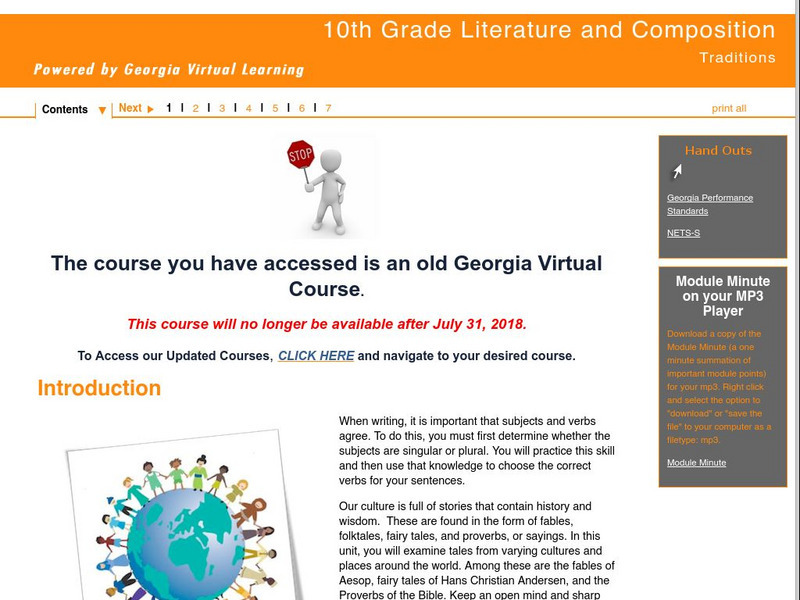Hi, what do you want to do?
Curated OER
Writing Fables
Students develop a working skill of using graphic organizers for writing. The lesson notes that the best kind of organizer is one that is engaging to the appropriate audience. The assessment follows the rubric given in the lesson.
Curated OER
Reading Plot
In this problem and solution worksheet, 3rd graders read an Aesop fable and using a highlighter to highlight the problem and solution in the fable. Then students write the problem and solution in their own words. The worksheet gives 5...
Curated OER
American Folktales and Tall Tales
Middle schoolers explore the elements of American folktales. They discuss how they are passed on from generation to generation, how they use exaggeration, and how they convey a message or make a point. Students identify common elements...
Curated OER
Identifying the Theme in a Story
Students recognize Theme through the use of simple, short stories. Using Pro Quest, students begin by researching the literary element, theme, and how it can be identified. They then identify the themes in Aesop's Fables and...
Curated OER
Storytelling
Students explore the origins of folktales, fairytales, myths, legends, fables, and folktales in the ten lessons of this unit. A storytelling festival is held to feature the results of the variety of activities presented in the unit.
Curated OER
Myth, Legend and Folklore
Students examine the role of myths and folklore in the Native American culture. They listen to examples of oral history and write their own. They share their story with the class.
Curated OER
A Sip of Aesop From the Web
Third graders answer specific questions by conducting an Internet scavenger hunt. They write their own fable after reading many different fables on the Internet. They questions that they answer are included in this lesson.
Curated OER
Philanthropy in Literature
Students research philanthropy in three genres: a play, a fable, and a parable. Students read an Aesop fable and answer questions in groups. Students complete steps in two worksheets from 'The Good San Franciscan' and 'Someone Should.'...
Curated OER
Exploring Animals in Literature
Celebrate Be Kind to Animals Week while teaching empathy and allegory with creature-related texts
Curated OER
Studies of the Ancient World
Sixth graders, after taking a pretest, write a paragraph describing the difference between Athens and Sparta and write an article about the ancient Phoenicians, describing their contributions to world history. They compare democracy in...
Curated OER
What is a Philanthropist?
Students discuss the conceptual framework of philanthropy. In this introduction to philanthropy lesson, students define the term philanthropist and read the story Lion and the Mouse. Students discuss the concepts of philanthropy...
Council for Economic Education
You Can Bank On This! (Part 3)
Young scholars use a chart to show how gaining interest is a beneficial part of having a savings account. In this banking lesson plan, students also learn about the workings of an ATM and a checking account.
Curated OER
Worksheet 2/7 on Nouns
In this adding nouns to sentences worksheet, students use nouns in a word bank to fill in the missing nouns and complete the passage, "Tortoise of the Galapagos Islands". Students add 31 nouns.
Curated OER
Learning Activities: Magic Words
Students use poetry to compare and contrast humans and frogs.
Curated OER
Literature of the Ancient World
The literature of the ancient world can provide a motivating way for students to explore history.
Curated OER
Understanding Cultural Diversity
First graders examine different types of art to help them explain the idea of cultural diversity. This is a unit focusing on works of art.
Georgia Department of Education
Ga Virtual Learning: Fable Writing Assignment [Pdf]
This two-page PDF is a literary analysis essay writing assignment for students after reading several of "Aesop's Fables." It explains the assignment, provides specific examples for parts of the assignment, and offers links to resources...
John F. Kennedy Center
The Kennedy Center: Elements of Fables
This ArtsEdge unit on fables shows how to compare and contrast, read and write fables, and discuss the elements they contain. Has great links, definitions, and fable examples.
Georgia Department of Education
Ga Virtual Learning: 10th Grade Literature and Composition: Traditions
This is a unit on the traditional wisdom of various cultures handed down through fables, fairy tales, folklore, and proverbs. It includes readings from Aesop's Fables, African and African-American Folktales, Hans Christian Andersen's...
AdLit
Ad lit.org: Discussion Guide: The Fabled Fourth Graders of Aesop Elementary School
Candace Fleming writes contemporary stories built around Aesop's fables in The Fabled Fourth Graders of Aesop Elementary School. No one wants to teach the fourth graders until the amazing Mr. Jupiter comes along. He undertakes the task...
Other
Storytelling to Assess Speaking and Listening
An effective use of rubrics that encourages the student storyteller how to determine if his/her audience is listening. Learn about the different listening skill rubrics, storytelling rubrics and a self-assessment guide that asks the...
ClassFlow
Class Flow: Fabulous Fables
[Free Registration/Login Required] This flipchart reviews the characteristics of a fable, gives some history of Aesop with a video clip. Student assessment questions and web links are included. Students end with an original writing...
Science Education Resource Center at Carleton College
Serc: Investigative Case: Protistan Tales of Atlantic White Cedar Swamps
A WebQuest where students explore microbial diversity by looking at the extreme habitat of the Atlantic White Cedar Swamp. Students will learn about protists through personification theme of Aesop's Fables. At the end of the...





















![Ga Virtual Learning: Fable Writing Assignment [Pdf] Unknown Type Ga Virtual Learning: Fable Writing Assignment [Pdf] Unknown Type](https://static.lp.lexp.cloud/images/attachment_defaults/resource/large/FPO-knovation.png)





